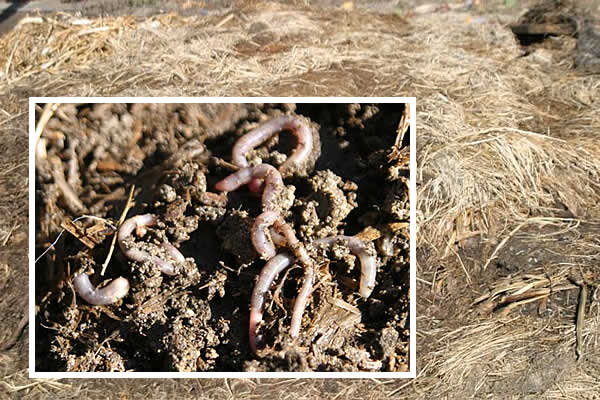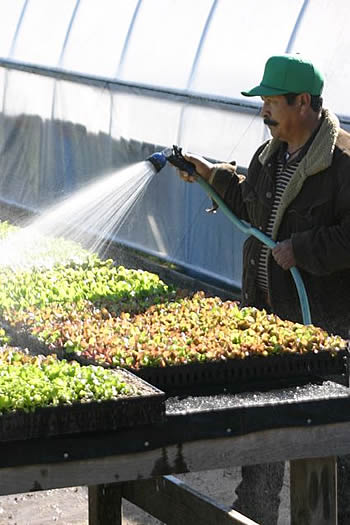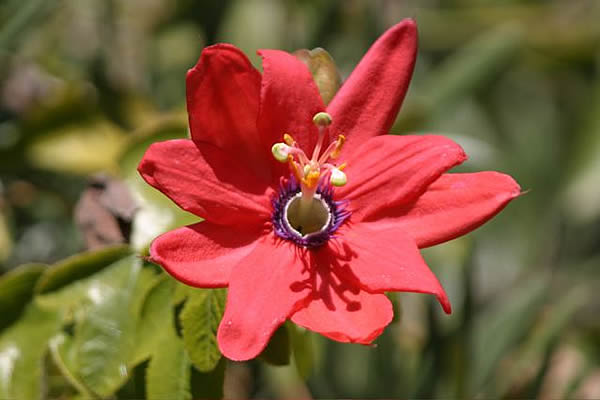
~~~~~~~~~~~~~~~~~~~~~~~~~~~~~~~~~~~~~~~~~~~
Live Earth Farm (Com)Post
6th Harvest Week, Winter 2007/2008
February 6th, 2008
~~~~~~~~~~~~~~~~~~~~~~~~~~~~~~~~~~~~~~~~~~~
In this issue
--Greetings from Farmer Tom
--What's Up on the Farm
--Pictures around the farm
--What's in the box this week
--Notes from Debbie's Kitchen
--Contact Information
"We are all here for each other. "
~ Michael Phillips, farmer
Greetings from Farmer Tom
~~~~~~~~~~~~~~~~~~~~~~~~~~~~~~~~~~~~~~~~~~~~~~~~
"We are here for each other" were the simple but inspiring words of Michael Phillips, a New Hampshire apple farmer, and one of the presenters at this year’s Ecological Farming Conference. Farmers like Michael Phillips practice and live by a philosophy which carries a deep understanding of how life builds on life, and how the health of our food depends on the health of all beings, including ourselves. Rather than falling into an all too common mentality of "divide and conquer" when dealing with common pests and diseases, Michael's detailed and practical orchard management techniques focus on building symbiotic relationships, mimicking ecosystems such as found along the edge of forests.
If my role as a farmer is to offer life-enhancing food to our community, then I have to pay attention to the ebb and flow of microorganisms, root growth, nutrient cycles and organic matter in the soil. Just by paying attention and enhancing the soil conditions to promote a healthy environment for earthworms to thrive in, I can count on more than 5 tons of nutrient rich castings to renew our soil every year. Even Cleopatra was aware of their importance of maintaining healthy soils along the Nile's floodplain and decreed that earthworms be revered and protected by all her subjects as sacred. Michael's philosophy of "being here for each other" suddenly becomes a lot more complex and profound. Instead of a greater separation, we suddenly find a closer interconnectedness with earthworms – and for that matter with nature as a whole.
It may take me some time before our earthworms have their own shrine here on the farm, but in the meantime I will make sure they live a good life, feasting on generous amounts of decomposing organic matter. Your role as members of this farm has suddenly taken on a new dimension, you are an active participant in supporting an ever renewing web of life forms which are working to bring healthy food to your table. "Being here for each other" can be seen both as ‘Community Supported Agriculture’ and ‘Agriculture Supported Community’. I believe in what Einstein once said, "Imagination is far more important than knowledge.” It allows us to see that bigger picture, where we are not just one organism, but many. We are truly here for each other.
- Tom

(the compost pile the Montessori school group started last fall... and its happy inhabitants!)
<back to top>
What's Up on the Farm
~~~~~~~~~~~~~~~~~~~~~~~~~~~~~~~~~~~~~~~~~~~~~~~~
I asked Tom to give us a behind-the-scenes look at what was currently happening
on the farm. It may be second nature to him, but many of us urbanites are so
far removed from what’s involved in growing our food that it’s nice
to get these little ‘farmer know-how nuggets’ from time to time.
I am always humbled and astounded by the layers of intricacy, timing, planning
and coordination.
- Debbie
Tom says, “We are finally getting a break from the rain, and I am secretly
hoping it's going to stay like this long enough (2-3 weeks) to plant our first
batch of seedlings waiting in the green house (i.e. lettuce, fennel, broccoli,
leeks, and leafy greens) and sow our first crop of sugar snap peas, carrots,
beets, radishes, and mustard greens. It is that window we always hope for, so
as to not fall behind with our harvest schedules in early April. Our peppers,
tomatoes and eggplants are already sown, but they won’t be transplanted
into the field until sometime in March/April. The orchards are pruned and so
are the blackberries and raspberries. This week, 150 bare-rooted Warren Pear
trees are scheduled to arrive, which we also hope to plant in the next couple
of weeks. Winter weeding is always laborious, but critical for all the over-wintering
crops such as garlic, onions, strawberries, and raspberries, to ensure their
healthy development.”
<back to top>
Pictures around the farm
~~~~~~~~~~~~~~~~~~~~~~~~~~~~~~~~~~~~~~~~~~~~~~~~

Juan watering the seedlings
which have been moved
out of the greenhouse into
the sun.
Montessori students harvesting Brussels sprouts...

Another Thomas (above, in red), a future farmer?

No, this is not Hawaii. Hard to believe, but this beautiful, tropical-looking
flower is blooming on the farm in early February! This is a passionfruit
vine blossom, sez Tom.
What's in the box this week
~~~~~~~~~~~~~~~~~~~~~~~~~~~~~~~~~~~~~~~~~~~~~~~~
Remember, sometimes there are last-minute substitutions not reflected
in this list!
Apples (Bobby Silva)
White beets
Brussels sprouts on the stem
Green cabbage
Red cabbage
Carrots
Chard
Red Russian kale
Leeks (Lakeside)
Rutabagas
Winter squash (Butternut or Kabocha) (Lakeside)
Giant turnips (Lakeside)
Bread (this week for the Santa Cruz County pickup locations: LEF, Soquel, Aptos/Wavecrest,
Seabright, West SC/Baldwin, Scotts Valley/Skypark)
<back to top>
Notes from Debbie's Kitchen
~~~~~~~~~~~~~~~~~~~~~~~~~~~~~~~~~~~~~~~~~~~~~~~~
Click
here to go to recipe database
Tom’s Winter Squash and Leek Soup
I had dinner with Tom and his family, as well as others from the farm who were
going to the Eco-Farm conference, and he made this absolutely delicious soup!!
I asked him to describe how he made it so I could share it with you guys. It
was incredibly rich, yet no stock was used. I’m going to try it myself
this week:
1st, bake or roast your winter squash (Butternut or Kabocha would do fine) until
completely soft, preferably until slightly caramelized [you all have your own
ways to do this; any method will be fine!]
2nd, sauté a bunch of chopped up leeks in butter and/or olive oil, ideally
until golden and starting to brown. [Tom sez he almost burned the leeks, but
I think getting them well caramelized really added to the flavor!]
3rd, cut up cooked winter squash, combine with leeks, add more butter [he added
half a stick, but then he was making soup for 8] and puree either with an immersion
blender or in batches in a regular blender, adding water and/or milk in order
to thin to desired consistency [you could also use vegetable boullion or chicken
stock if you wanted to, and it would be even richer, but obviously it was not
necessary in this case!]
4th, add salt and pepper to taste. Tom says he also added some garlic powder,
but if you’re like me and don’t have garlic powder, you could just
as easily add a couple cloves of crushed fresh garlic to the sautéeing
leeks in step 2. Just remember: don’t add it until the last minute or two
as it cooks quickly and you don’t want to burn the garlic!
That’s it – so simple, yet so flavorful. It’s the quality of
ingredients that make it, I say!
Ginger-Glazed Young Turnips with Cider and Raisins
from Farmer John’s Cookbook
Serves 4
Tom tells me we’re getting ‘giant turnips’ from Lakeside this
week, so I’m going to go out on a limb and say you can make this recipe
even though we’re not getting ‘young’ turnips! I’ll write
the recipe as it appears in the cookbook; the only thing I would do differently
is in the first step, I’d cut the turnips up into quarters or eighths (depending
on how big they turn out to be) before boiling them. Check their skin: if it’s
gnarly, peel them, if it looks good, you can likely just scrub them well and
cook them with their skins on. – Debbie
Here’s the opening blurb in the cookbook: “This is a spectacular
way to serve young turnips. Their refresing taste and texture is enhanced, but
not overwhelmed, by an exciting, sweetly pungent sauce made from fresh ginger
and juicy sweet raisins. Ginger lovers will want to use lots of ginger, but even
in its mildest version, this dish is superb. To make the most of the great flavors
in this recipe, serve it over jasmine rice.”
½ tsp. salt, plus a dash, divided
1 bunch young turnips, trimmed
¼ C sugar or honey
1/8 C white vinegar [I think I’d use cider vinegar]
1 to 2 tsp. freshly grated ginger (or more, to taste)
2 tbsp. cornstarch
¼ C apple or grape cider
½ C raisins
2 tbsp. finely chopped fresh parsley
finely chopped crystallized ginger (optional garnish)
1. Bring 2 quarts water to a boil in a large pot. Add a dash of salt, then the
turnips. When the water returns to a boil, cover and reduce heat. Simmer the
turnips gently until tender but not mushy, 10 to 15 minute depending on size.
Remove the pot from heat and transfer the turnips to a dish to cool [save some
of the cooking water! see next step].
2. Meanwhile, transfer ½ C of the hot cooking water to a medium pot. Stir
in the sugar or honey, vinegar, and ginger to taste. Add ½ tsp. salt.
3. Combine the cornstarch and cider in a small glass or bowl; let stand until
cornstarch is dissolved.
4. Slice the turnips to your desired thickness.
5. Place the pot with the ginger mixture over medium heat. Stir in the cider/cornstarch
mixture and adjust the heat so the ingredients simmer. Cook, stirring constantly,
until the mixture is smooth and thickened, 2 to 3 minutes.
6. Remove the pot from heat; stir in the raisins and sliced turnips and continue
to stir for 2 minutes, until the mixture reaches a thick, gravylike consistency.
If necessary, stir in a bit more cider to reach the desired consistency. Stop
stirring and let stand for 2 mintes. Garnish with parsley and crystallized ginger.
Pureed Rutabagas with Pan-Fried Leeks
from Asparagus to Zucchini (original source = Roots: The Underground Cookbook)
Serves 4
6 C peeled and diced rutabagas
6 tbsp. olive oil, divided
1 large leek, thinly sliced and separated into rings
2 tbsp. butter, room temperature
¼ C half-and-half
¼ tsp. ground nutmeg
¼ tsp. salt
¼ tsp. freshly ground white pepper
Cover rutabagas with lightly salted water in a medium saucepan; cook until tender,
20-25 minutes. Meanwhile, heat 4 tbsp. olive oil in medium skillet over medium
heat; add and sauté leeks until dark brown. Drain on paper towels; reserve.
Drain rutabagas and purée with butter, the remaining 2 tbsp. olive oil,
half-and-half, nutmeg, salt and pepper. Spoon or pipe rutabaga purée into
individual dishes; sprinkle leeks on top. Serve hot.
Lemony Leek Soup
from Recipes From a Kitchen Garden
Serves 6 – 8
1 tbsp. butter
2 tbsp. vegetable oil
6 C thinly sliced leeks
1 carrot, thinly sliced [farm carrots are small; probably want to use more than
one I’m guessing]
1 stalk celery, thinly sliced (or use celeriac)
6 C chicken stock
2 tsp. fresh marjoram or 1 tsp. dried
1 tbsp. grated lemon zest
2 tbsp. lemon juice
1 tbsp. chopped fresh parsley
¼ C raw white rice
½ C milk
salt and white pepper
sour cream or yogurt and minced chives (for garnish)
Heat butter and oil in a large saucepan; add leeks, carrots and celery, and sauté until
soft. Add stock, marjoram, lemon zest, lemon juice, parsley and rice; cover and
simmer until vegetables are tender, about 40 minutes. Purée in batches
in a blender or food processor then return mixture to saucepan. Add milk, salt
and white pepper to taste. Heat but do not boil. If soup is too thick, add more
stock or milk. Serve hot or cold, garnished with sour cream or yogurt and chives.
Grated Turnip (or Rutabaga) and Apple Salad
from Sundays at Moosewood Restaurant
serves 4 to 6
1 C peeled and grated raw turnips or rutabaga
1 C peeled and grated tart apples
½ C chopped fresh parsley
juice of one large lemon
1 tbsp. vegetable oil
salt and freshly ground black pepper to taste
Combine everything, toss, cover, and chill.
<back to top>
Contact Information
~~~~~~~~~~~~~~~~~~~~~~~~~~~
email Debbie at the farm (for any farm or CSA share-related business): farmers@cruzio.com
email Debbie at home (with newsletter input or recipes): deb@writerguy.com
farm phone: 831.763.2448
website: http://www.liveearthfarm.net
~~~~~~~~~~~~~~~~~~~~~~~~~~~